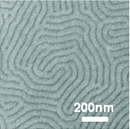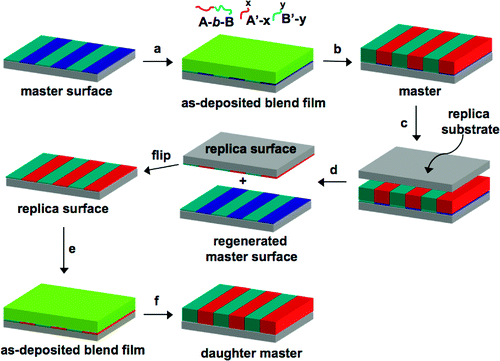
“Here we report an approach for replicating geometrically complex patterns over macroscopic areas with feature dimensions of order 10 nm. The technique, called ‘molecular transfer printing’ (MTP), takes advantage of patterns in the domain structure at the surface of block copolymer films, and transfers those patterns with high fidelity to substrates placed in contact with the copolymer film. In MTP, reservoirs of inks in copolymer domains promote saturation of molecular transfer at the replica surface. Technologically useful patterns may be created from self-assembled block copolymer films, or by directing the assembly of block copolymer films on lithographically-defined chemical pre-patterns. For the latter case, the pattern from which transfer occurs (and thus the resulting pattern by MTP) may be of superior quality (perfection, registration, uniformity of feature dimensions) and at higher resolution than the initial, lithographically defined pre-pattern.”
The Molecular Transfer Printing Process
Below is a typical molecular transfer printing (MTP) process. In the first step, a thin film blend of a block copolymer and inks is deposited on a substrate. This thin film then self assembles into phase segregated domains, with the inks concentrating in their respective block copolymer domains. After a clean substrate makes contact with the surface of the assembled film, the inks will transfer to and covalently bond with that substrate upon thermal annealing. The transferred ink pattern mirrors the domain structure of the original thin film blend. A washing can restore the original master surface.

Figure1 shows a schematic of molecular transfer printing (MTP). (a) A’-x and B’-y are inks, with reactive functional groups x and y, that are blended and deposited with block copolymers (A-b-B) on a substrate. (b) Upon annealing, the blended block copolymeric film micro-phase segregates, with inks A’ and B’ sequestered in their corresponding compatible polymeric blocks, i.e. A’ within A and B’ within B. This separation and concentration of the inks creates the “master” pattern. (c) When a second substrate makes contact with the phase segregated thin film, the inks transfer to that new substrate by absorption, chemical reaction or some other attractive interaction. The image transferred to the second substrate mirrors that of the master pattern. (d) The patterned replica can be released from the master pattern, which can be used multiple times, by dissolving the block copolymer thin film. (e) This process may be repeated with the replica (f) to create a copy of the master pattern.
References
- Shengxiang Ji, Chi-Chun Liu, Guoliang Liu and Paul Nealey, Excerpt from ACS nano 2010;4(2):599-609.
- Kim, S. O.; Solak, H. H.; Stoykovich, M. P.; Ferrier, N. J.; de Pablo, J. J.; Nealey, P. F. Epitaxial self-assembly of block copolymers on lithographically defined nanopatterned substrates. Nature 2003, 424, 411-414.
- Stoykovich, M. P.; Muller, M.; Kim, S. O.; Solak, H. H.; Edwards, E. W.; de Pablo, J. J.; Nealey, P. F. Directed assembly of block copolymer blends into nonregular device-oriented structures. Science 2005, 308, 1442-1446.
- Stoykovich, M. P.; Kang, H.; Daoulas, K. C.; Liu, G.; Liu, C. C.; de Pablo, J. J.; Mueller, M.; Nealey, P. F. Directed self-assembly of block copolymers for nanolithography: Fabrication of isolated features and
essential integrated circuit geometries. Acs Nano 2007, 1, 168-175. - Wilmes, G. M.; Durkee, D. A.; Balsara, N. P.; Liddle, J. A. Bending soft block copolymer nanostructures by lithographically directed assembly. Macromolecules 2006, 39, 2435-2437.
- Ruiz, R.; Kang, H.; Detcheverry, F. A.; Dobisz, E.; Kercher, D. S.; Albrecht, T. R.; de Pablo, J. J.; Nealey, P. F. Density multiplication and improved lithography bydirected block copolymer assembly. Science 2008, 321, 936-939.
- Cheng, J. Y.; Rettner, C. T.; Sanders, D. P.; Kim, H.; Hinsberg, W. D. Dense self-assembly on sparse chemical pattern: Rectifying and multiplying lithographic patterns using block copolymers. Adv. Mater. 2008, 20, 3155-3158.
- Tada, Y.; Akasaka, S.; Yoshida, H.; Hasegawa, H.; Dobisz, E.; Kercher, D.; Takenaka, M. Directed Self-
Assembly of Diblock Copolymer Thin Films on Chemically-Patterned Substrates for Defect-Free Nano-
Patterning. Macromolecules 2008, 41, 9267-9276. - Bita, I.; Yang, J. K. W.; Jung, Y. S.; Ross, C. A.; Thomas, E. L.; Berggren, K. K. Graphoepitaxy of self-
assembled block copolymers on two-dimensional periodic patterned templates. Science 2008, 321, 939-943.
Excerpt and Images reproduced with permission from Ji S, et al. 2010. Molecular Transfer Printing Using Block Copolymers. ACS Nano 4(2): 599-609. DOI: 10.1021/nn901342j. Copyright 2010 American Chemical Society.
